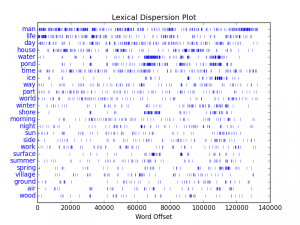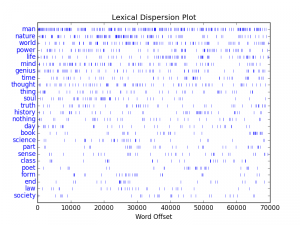My second Python script, dispersion.py
Posted on November 19, 2014 in UncategorizedThis is my second Python script, dispersion.py, and it illustrates where common words appear in a text.
#!/usr/bin/env python2 # dispersion.py - illustrate where common words appear in a text # # usage: ./dispersion.py <file> # Eric Lease Morgan <emorgan@nd.edu> # November 19, 2014 - my second real python script; "Thanks for the idioms, Don!" # configure MAXIMUM = 25 POS = 'NN' # require import nltk import operator import sys # sanity check if len( sys.argv ) != 2 : print "Usage:", sys.argv[ 0 ], "<file>" quit() # get input file = sys.argv[ 1 ] # initialize with open( file, 'r' ) as handle : text = handle.read() sentences = nltk.sent_tokenize( text ) pos = {} # process each sentence for sentence in sentences : # POS the sentence and then process each of the resulting words for word in nltk.pos_tag( nltk.word_tokenize( sentence ) ) : # check for configured POS, and increment the dictionary accordingly if word[ 1 ] == POS : pos[ word[ 0 ] ] = pos.get( word[ 0 ], 0 ) + 1 # sort the dictionary pos = sorted( pos.items(), key = operator.itemgetter( 1 ), reverse = True ) # do the work; create a dispersion chart of the MAXIMUM most frequent pos words text = nltk.Text( nltk.word_tokenize( text ) ) text.dispersion_plot( [ p[ 0 ] for p in pos[ : MAXIMUM ] ] ) # done quit()
I used the program to analyze two works: 1) Thoreau’s Walden, and 2) Emerson’s Representative Men. From the dispersion plots displayed below, we can conclude a few things:
- The words “man”, “life”, “day”, and “world” are common between both works.
- Thoreau discusses water, ponds, shores, and surfaces together.
- While Emerson seemingly discussed man and nature in the same breath, but none of his core concepts are discussed as densely as Thoreau’s.
Python’s Natural Langauge Toolkit (NLTK) is a good library to get start with for digital humanists. I have to learn more though. My jury is still out regarding which is better, Perl or Python. So far, they have more things in common than differences.








